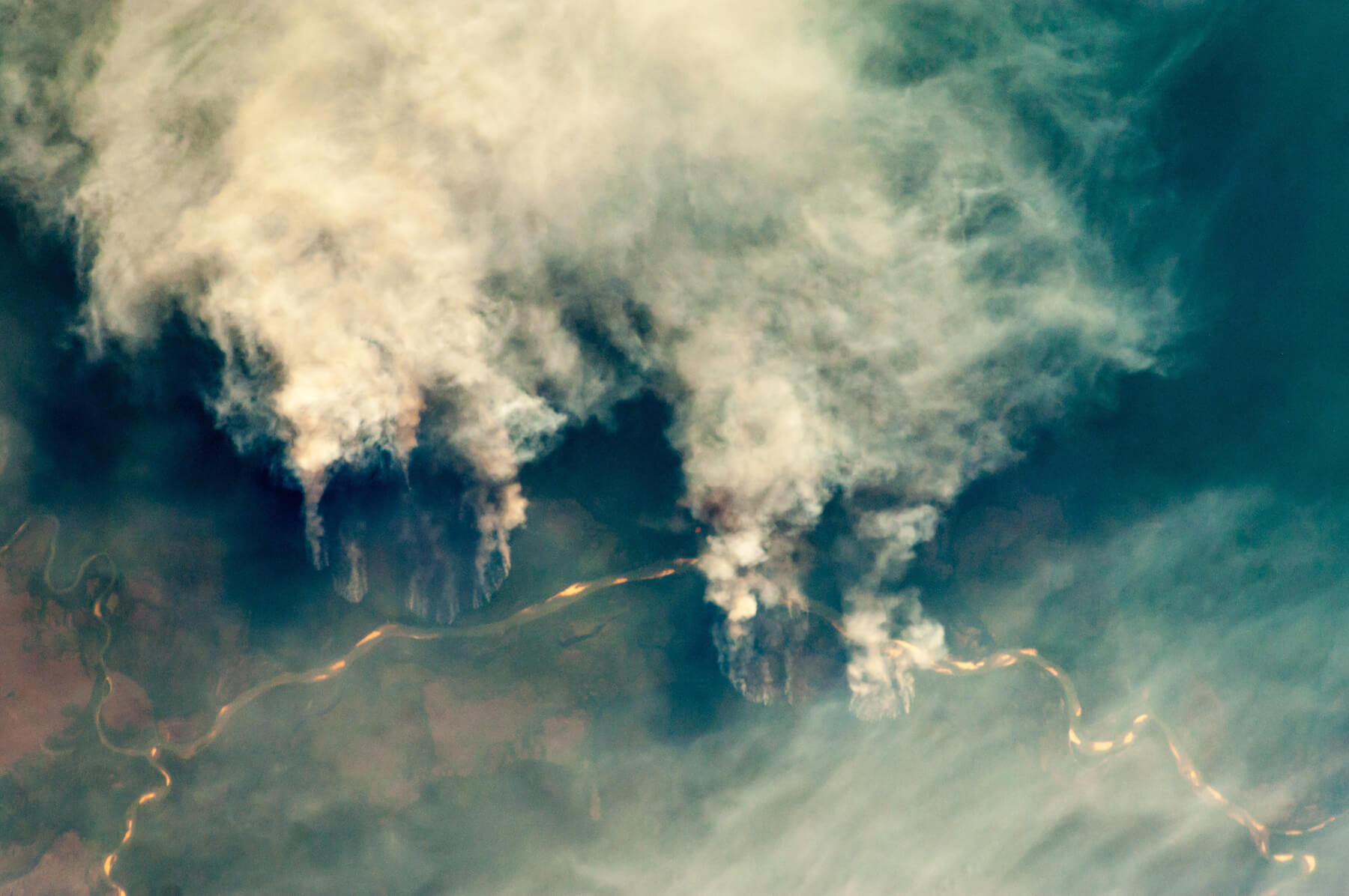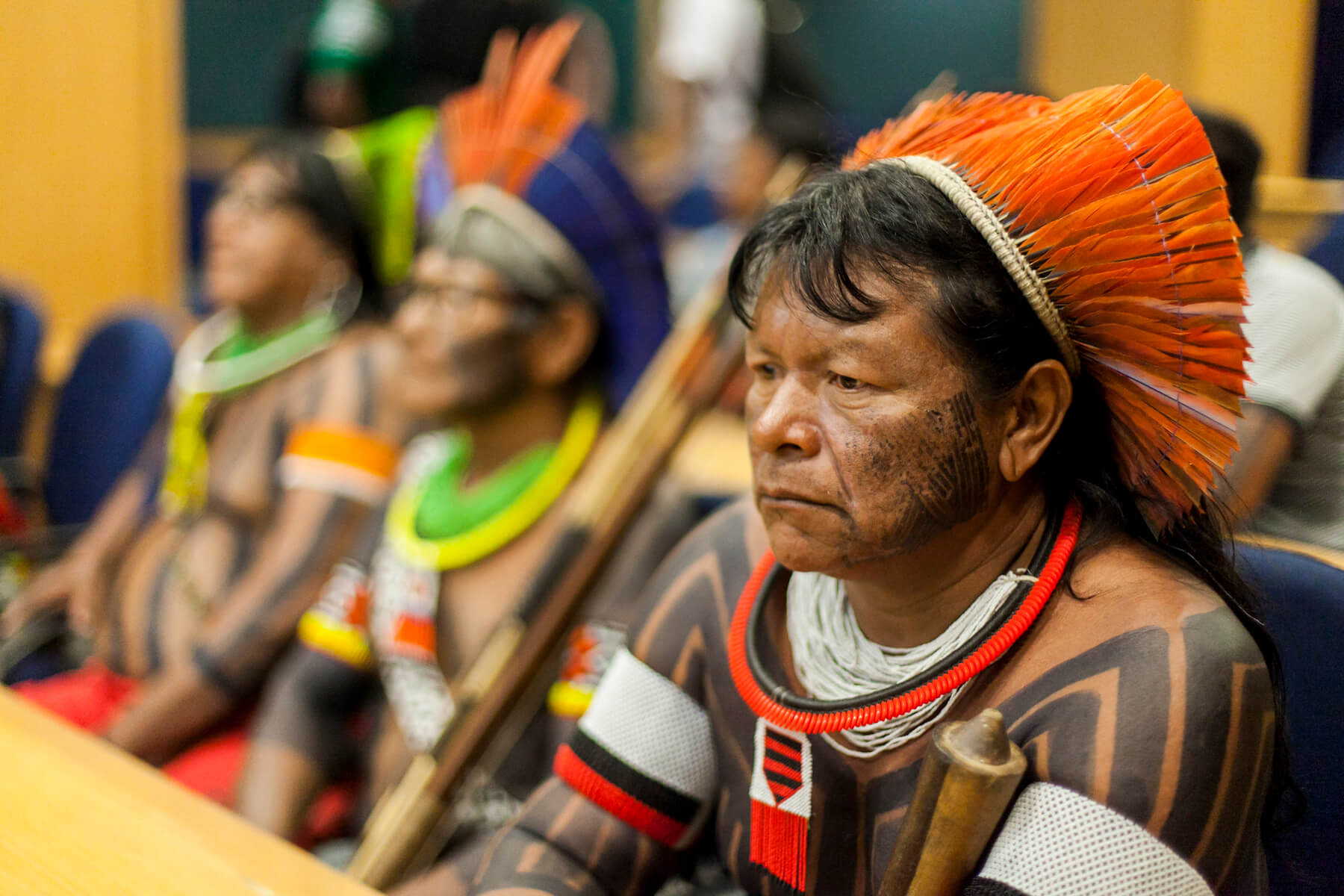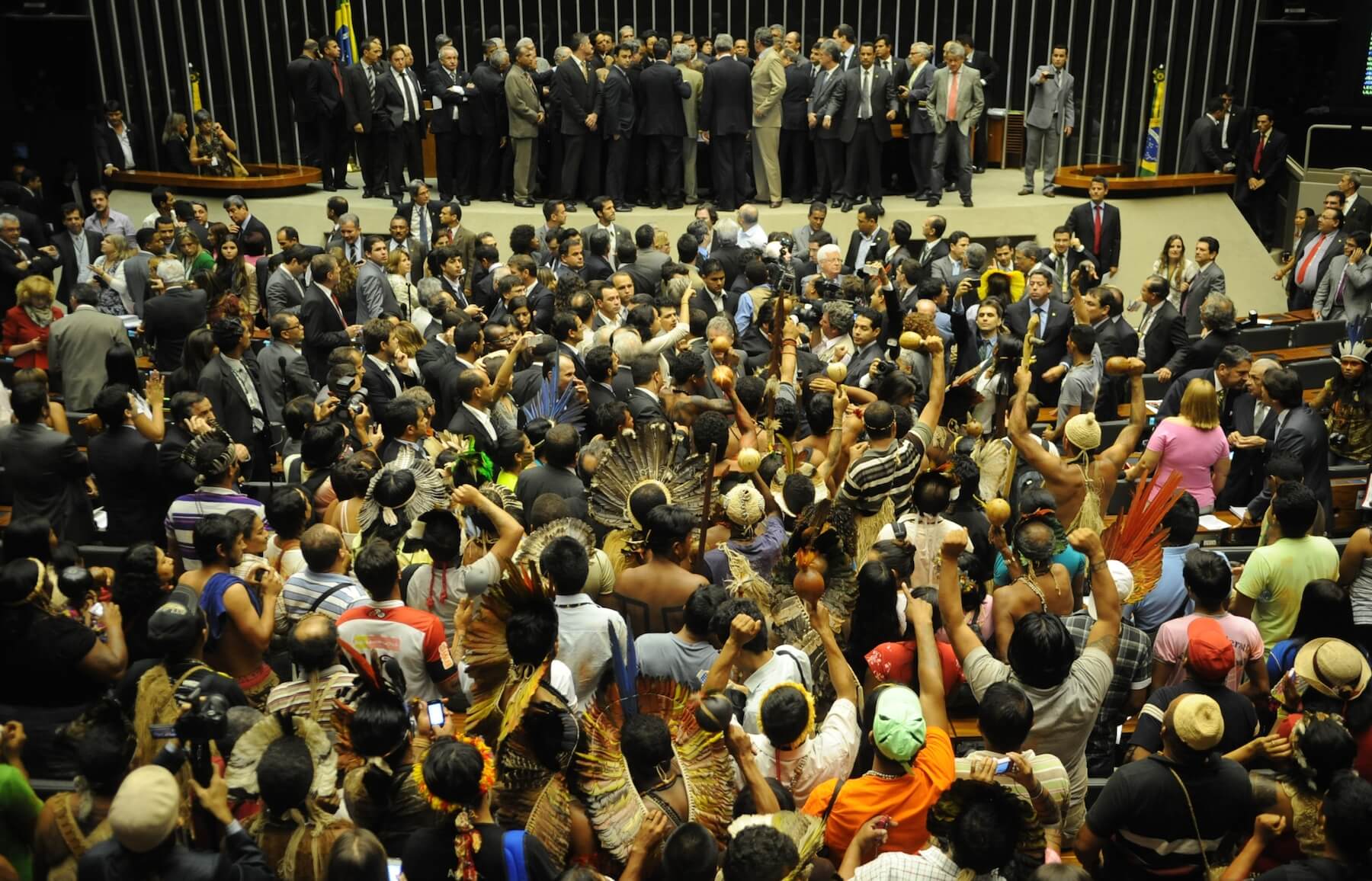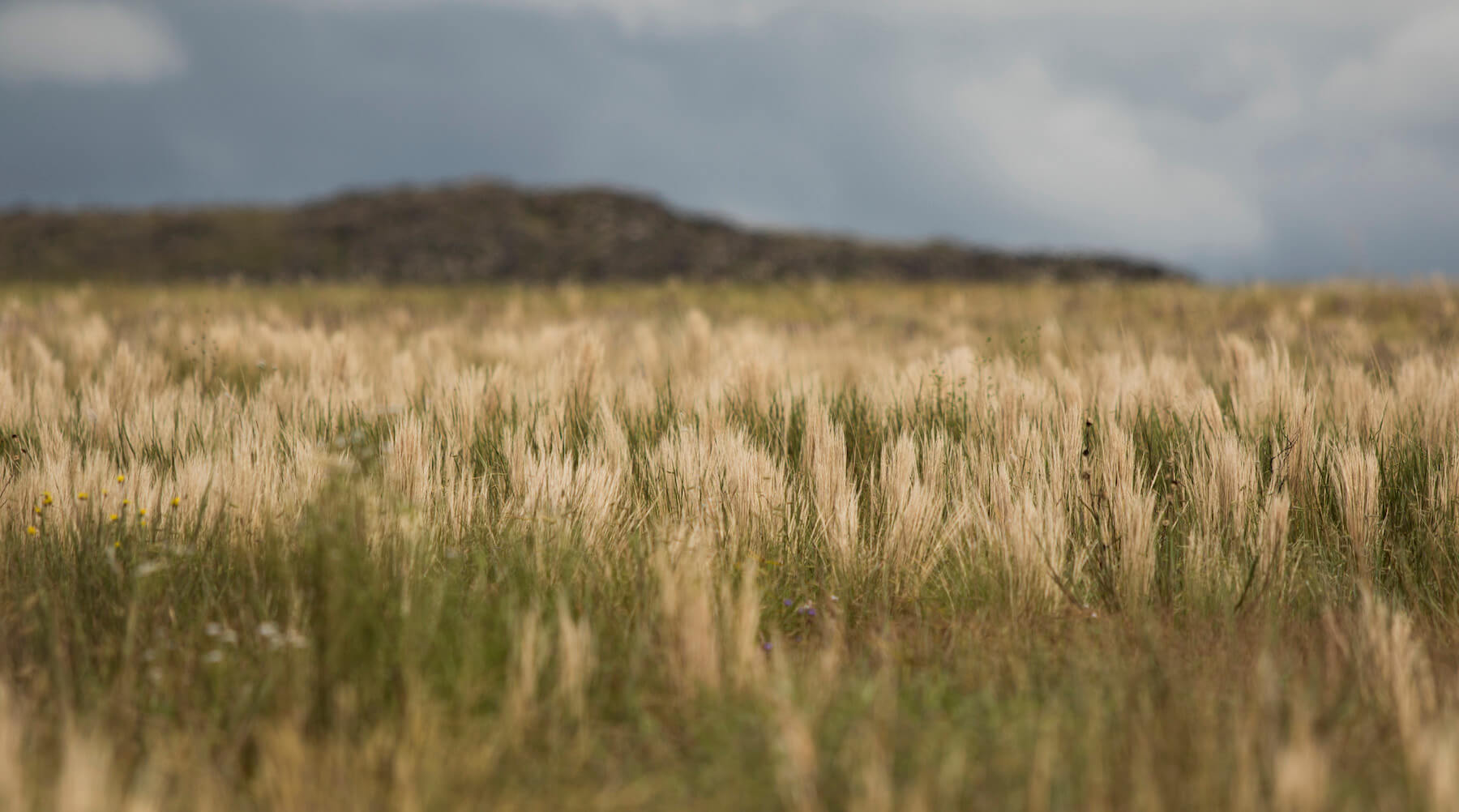
Inside the United Nations headquarters, amid a whirlwind of languages he does not know, Hiparidi Top’tiro prepares to speak. He has traveled from the Brazilian savannah all the way to the heart of New York City to address this room.
He takes his seat in an atrium that bustles with ambassadors, diplomats, and representatives who have come from around the world to attend the 17th Session of the UN Permanent Forum on Indigenous Issues.
It’s a defining moment for indigenous leaders from every continent, who are afforded a rare podium at which to confront their political representatives about the injustices dealt to them. Many sit in silence and await their time to tell the world about the lands being stolen from under the feet of their loved ones, the many sacred grounds now exploited and sold for profit.
Top’tiro represents the A’uwe-Xavante people from Mato Grosso. It’s a state nestled in Brazil’s tropical savannah, an endangered biome known as the Cerrado. Though the region contains five percent of the entire world’s biodiversity (including endangered species like the jaguar and giant anteater), is an integral source of water for millions, contains half of the country’s watersheds (including the largest wetland in the world), and provides 90 percent of Brazilians with hydroelectric power, unsustainable practices on the behalf of soy companies have led to half of the entire savannah being destroyed.
“Agribusiness is destroying our dreams, the source of our spirituality and our future.”
The Xavante have been in contact with white people for only a little over 60 years, but in that short time they have come to witness the death of their homeland at the hands of soy exporters from Europe and America.
“Agribusiness is destroying our world: the Ró,” says Top’tiro. He addresses the room in his native Portuguese, struggling at first to speak over the clamor of so many listeners. “The Ró is the Cerrado and all of the beings that live within it. It is the source of our strength.
“Agribusiness doesn’t just destroy the forest that surrounds our territories,” he continues. “It pollutes the rivers where we perform our rituals, that we bathe in, and the water we drink. It contaminates the air. Because of this, agribusiness is destroying our dreams, the source of our spirituality and our future.”
Top’tiro’s home happens to be one of Brazil’s leading soy exporting states. The soy monocultures are cultivated on the indigenous lands of Mato Grosso by farmers who sell their product to behemoth American corporations like Bunge and Cargill, who then harness it as feed to fuel the global cattle industry.
A recent report published by the not-for-profit group Mighty Earth discovered that these mega suppliers are directly responsible for the deforestation of massive tracts of indigenous lands in both the Cerrado and Amazon basin. But the destruction of sacred territories is unfortunately only the beginning of the problem for the A’uwe-Xavante and so many other indigenous communities.
Driving this well-documented and crippling deforestation is an industry so economically compelling that it can twist the laws and pockets of the Brazilian government to get away with theft and murder, all while consumers buy into a destruction they don’t know they’re sponsoring.

Slash-and-burn forest clearing and land conversion along the Xingo River in northeast Mato Grosso, Brazil, as seen from the International Space Station. Amazonia has experienced continual deforestation efforts since the early 1960s.
Chapter One: Rivers Beyond Borders
By the time Top’tiro has concluded his speech to the UN, he is utterly depleted. His accompanying representative, Laura Graham, does her best to secure the leader some space to recoup. When I finally get both of them on the line, Top’tiro is fatigued. Graham acts as his spokeswoman, translating Portuguese to English.
“Fortunately, the laws have become stricter to limit the agribusinesses that are looking to set up shop in many regions of the Amazon,” she tells me. “But because of the strict laws these agribusinesses are now moving into the Cerrado, and the destruction there is way more rapid. Yet it’s still flying under the radar of the general public consciousness.”
Graham is a board member of the organization Cultural Survival, one of the indigenous rights groups that helped facilitate the United Nations Forum. The NGO has been partnering with indigenous communities and international advocates around the world for more than 46 years. Their work is predicated on the United Nations Declaration on the Rights of Indigenous Peoples, which was passed in 2006.
The agreement between more than 144 nations (the United States originally voted against it, but four years later changed its stance) helped to establish a framework of rights for indigenous peoples. One of these specific rights outlined in the agreement is known as Free, Prior, and Informed Consent (FPIC), which recognizes that indigenous communities have the power to approve or deny any projects that might affect them or their territories.
It is precisely this standard of the Declaration that is being directly violated by both agribusinesses and new legislation introduced in the Brazilian congress.
When Top’tiro and his representatives pressure congress in support of his people, they hear repeatedly that the mandate applies only to Amazonia, and therefore the Cerrado is beyond helping.
Any pollutants or toxic agents introduced into Cerrado streams leach out and affect the rest of the ancient rainforest.
But rivers betray map-bound territories and inevitably enmesh that which is protected with that which is not. The Xavante people have settled along tributaries in the Cerrado, next to headwaters that flow directly into the Amazon and help feed it. Any pollutants or toxic agents introduced into their streams (such as those used ubiquitously by soy agrigiants) leach out and affect the rest of the ancient rainforest.
While there are some small farms, since the 1970s most of the soy ranches in the Cerrado have become government-facilitated projects designed to bring large-scale agriculture business into the area. First, settlers were ushered in and corporations received massive tracts of land. What began as cattle ranching quickly evolved to encompass rice cultivation, and when soy cultigens were adapted to the tropical climate in the 1990s, the industry began to boom. The growing and incessant need for animal feed in Europe, China, and eventually America became the insatiable market share that continues to dominate today.
The soy cultivation practices, Graham emphasizes, have been particularly aggressive.
“Many of these soy ranches use crop dusting,” she says. “In the cases of the Xavante land that these industries still can’t access, they’ll plant right up to the border. Those chemicals inevitably drift into the indigenous territories and sicken the people and animals.”
Top’tiro has witnessed the horrifying repercussions of these herbicides and pesticides firsthand in his community.
In Mato Grosso, the A’uwe-Xavante people live in small reserves that still rely on hunting and gathering to nourish their communities. When Xavante hunters kill and eat animals that have entered soy ranches and consumed agrochemicals, they too consume toxic amounts of pesticides and fertilizers.
Top’tiro has witnessed the horrifying repercussions of these herbicides and pesticides firsthand in his community, including above average rates of congenital birth defects, hypothyroidism, immune system disorders like lupus and rheumatoid arthritis, fertility and pregnancy problems, and reports on indigenous health that have been covered up.
Just last year, a truck filled to the brim with pesticides came throttling down one of the federal highways, BR070 e, which cuts through the Xavante reserve. The driver collided with a barrier and tipped the loaded semi over onto the road. Pesticides leaked out of the back and seeped onto the concrete, just as a group of Xavante children wandered out of the surrounding forest and stumbled upon the wreckage.
“The kids walked over to the spill, and started playing in the toxic chemicals,” says Graham. “Picking it up with their hands. It didn’t get any kind of environmental attention. And incidents like that are happening all of the time.”

On Wed, May 22, indigenous representatives of the Xavante, Kayapo, Bororo, Xoko, Tapeba, Tuxa, Guajajara, Paresi, Karaja, Yanomamy, and Kayapo peoples met at SESAI, Ministry of Health, Brazil, to debate the current model of managing work contracts in indigenous health areas. Photo: Flickr/MidiaNINJA.
Chapter Two: What's Yours Is Mine
The soy doesn’t just arrive by itself, Top’tiro explains. You have to build the roads first.
Agribusinesses began paving roads through the Cerrado as early as the 1980s, so that large semis could shuttle supplies to and from the ranches. More than 100 Xavante have been killed by these vehicles on the roads since then, including 10 people in the past two years alone. Men who are hunting and gathering, carrying heavy loads; women and children scouting for berries in the bramble; boys zooming along the highways on motor bikes.
“These aren’t like highways in the U.S.,” says Graham. “They don’t have shoulders, signs, or speed limits. A kid might be riding along and a truck is coming, so he hits the curb to try and get out of the way and the truck just runs him over.”
The rest of the tribe laid in the grass and watched in horror.
Top’tiro tells me about a memory that still haunts him, when in 2016 he witnessed a fully-loaded semi bound for its plantation diverge from its course on federal highway BR158 to scare off a group of Xavante men who had gathered on the side of the road. The younger men were able to leap to safety, but an older man was trampled to death while the rest of the tribe laid in the grass and watched in horror.
“The Brazilian government hasn’t upheld agreements to make the roads environmentally sound or safe for the communities they impact,” says Graham.
The next project Graham and Top’tiro stand to challenge is the construction of federal highway BR-080. Building it would result in the inevitable destruction of the ancient village site of Tsõrepré, the birthplace of the Xavante. Top’tiro is convinced that new projects such as this will ultimately cost the lives of more and more of his people.
There are some who recognize these impending dangers and are doing everything they can to fight them. Adriana Ramos is an environmental policy specialist and Executive Secretary of Socioenvironmental Institute (ISA), a Brazilian NGO established in 1994 to preserve the social and environmental rights of regions like the Cerrado. Though she’s been with the organization for more than two decades, the past six years have posed an entirely new set of threats and challenges to diffuse.
“When we look to the rural sector, especially in Brazil, the big producers of agriculture and cattle have ultimately decided that we’ve gone too far in limiting their profits,” says Ramos.
“They’ve improved their political power, because the political representatives of the rural sector in the Brazilian congress are land owners. They don’t want to see indigenous rights advancing, because that will mean taking lands away from the markets.”
According to the UN mandate of Free, Prior, and Informed Consent, indigenous people legally possess the right to approve or veto any projects affecting their territories. But the bancada ruralista agribusiness lobby in Congress and President Michel Temer’s administration both tenaciously defend the interests of the rural sector by undercutting environmental and social movements that stand in their way.
According to the UN mandate of Free, Prior, and Informed Consent, indigenous people legally possess the right to approve or veto any projects affecting their territories.
Brazil is currently attempting to emerge from the throes of its worst recession on record, and Ramos explains that large-scale agribusinesses whisper the potential for boosted exports and an overall increase in Brazil’s gross domestic product. In the name of closing the gap on the budget deficit, President Temer launched spending cuts that included reducing the environmental ministry by 40 percent.
Funding at the National Indian Foundation (FUNAI), the government sect responsible for ensuring the collective rights of Brazil’s nearly one million indigenous people, was also cut by 40 percent this year. Rural lawmakers believe the organization was awarding too much land to indigenous people. Furthermore, new proposals in Congress would reduce the size of conservation areas by more than one million hectares.
“What’s worrisome is that we’re only talking about 13 percent of the total territory being protected; lawmakers think it’s too much,” says Ramos.
“But in comparison with the availability of land for private ownership, it’s such a small amount — especially considering the total land of Brazil. We don’t understand why instead of thinking about better conditions for their private areas, the private sector is thinking of dispersing land that belongs to indigenous people and traditional communities.”
Other measures being parlayed through Congress could open the floodgates to the legalization of land grabbing, what locals refer to as grilagem. Amendments would endow landowners with the freedom to be granted tenure for their property, simply by registering the territories that they are occupying. It creates an impetus for land-hungry businesses to clear new areas of forest and seize public lands in order to receive official ownership under the new titling program.
The process has begun. It’s already opened up protected areas for two controversial projects in the Amazon: Brazil’s largest hydropower dams, the Jirau and Santo Antonio. Meanwhile, indigenous leaders continue ongoing battles to legally demarcate their lands.
It’s a political obstacle seemingly designed to be as difficult as possible to endure. First, Ramos explains, leaders open a demand for federal agents. These agents create a working group that will identify the territory that the community claims, and then officiate a report confirming that the community lives on the designated area, what size the area is, what portion of it the community uses for production, and the broader area that they rely on for their social and cultural reproduction.
In a rallying cry of rage, more than three thousand indigenous peoples stormed the front of the Attorney General’s Office to protest the “Opinion of the Genocide.”
After this report recognizes the territory, it’s then published as a legal identification and opens a 90 day opportunity for any interests who are affected by that recognition to present their arguments as to why they believe the land should not be recognized as an indigenous territory. Once the 90 days are up, federal agents must reach a consensus about whether or not they recognize the claims as legitimate.
Following this decision, the process then climbs to yet another level, in which the lands await definition for demarcation.
“It can stand on this level for years,” says Ramos. She explains that some communities have been stuck in this stage for more than 30 years, waiting for the Brazilian government to pen their rights.
According to a recent report published by the ISA, there are currently 45 indigenous territories that could be threatened by the new rural permit project. All of them are currently awaiting official demarcation, and already have infrastructure projects planned or in operation, which renders them vulnerable to being disregarded entirely in the eventual licensing process.
In a rallying cry of rage, more than three thousand indigenous peoples stormed the front of the Attorney General’s Office on April 25 to protest the unconventionality of Opinion 001/2017, which they’ve come to call “Opinion of the Genocide.”
“What we really need is a program to monitor what is happening in the Cerrado,” Ramos says, a sigh audible on the other end of the line. “We simply don’t have a way of showing the rest of the world yet what’s actually happening there.”

Revolting against the creation of a special commission to analyze the Proposal of the Amendment to the Constitution (PEC) 215, which gives the National Congress powers to demarcate indigenous lands, hundreds of indigenous peoples from the Amazon invaded the Chamber of Deputies plenary and took the seats of the parliamentarians. Photo: José Cruz/Agência Brasil
Chapter Three: Up in Flames
Anahita Yousefi has followed the destruction of both the Cerrado and Amazon for decades. She has worked tirelessly as a Campaign Director for the NGO Mighty Earth to document the aftermath from the invasive agriculture industries. Previously, she held senior positions within the government of Norway, where she was responsible for leading a number of bilateral partnerships with Latin American forest countries, including Norway’s flagship $1B partnership with Brazil.
In her recent investigative publication, The Ultimate Mystery Meat, Yousefi and her team take a closer look at the silent players who are funding the deforestation and land grabbing from behind the smokeshow of veiled global supply chains in the Cerrado.
“There are a lot of foreign investments in the deforestation and seizure of these indigenous territories,” she says. “Two of the major players are Cargill, in Minnesota, and Bunge, which is located in Westchester, New York.”
Three quarters of all soy produced on the planet is used for animal feed — demanding a swath of farmland larger than the combined total area of France, Germany, Belgium, and the Netherlands.
Both of these agribusiness groups pull in millions of dollars selling their soy feed to the meat industries who supply the livestock that Burger King uses to make its 11 million Whoppers and other sandwiches daily. In fact, three quarters of all soy produced on the planet is used for animal feed — demanding a swath of farmland larger than the combined total area of France, Germany, Belgium, and the Netherlands.
To conduct their investigation, Yousefi and her team visited 28 sites across 3,000 kilometers in Brazil and Bolivia. During their field investigations they employed satellite mapping, used aerial drones to follow tractors, implemented supply chain analysis tools, and conducted interviews with soy growers to reveal deforestation linked to agribusiness titans in the supply chain.
The Cerrado became an essential location to document during their reconnaissance. There are several soy companies that operate in the region, however Mighty Earth’s probe revealed time and again that American companies Bunge and Cargill were the two major culprits responsible for the destruction of the Cerrado.
The companies begin by purchasing soy from farmers, and proceed to ship it around the world to feedlots, where livestock consume it and eventually become fodder for sandwiches and burgers.
Although the companies begin by purchasing soy from farmers, Bunge and Cargill aren’t passive buyers; they behave as the very shadow entities behind leveraging political lobbying to fund the infrastructure projects that tear apart indigenous communities, including Top’tiro’s people.
“These actors don’t only buy the commodities from the farmers, they also make decisions on where they want to invest in roads and other infrastructure,” says Yousefi.
“They have a very close relationship with the farmers. They supply them with their pesticides. Investments provide them with agricultural interests, so they have immense leverage and control over farmer behavior.”
Across the hundreds of kilometers that Yousefi walked through the Cerrado, again and again she witnessed cleared areas of the savannah winding off into the horizon. She watched farmers use chemical sprays and systematic fires to burn debris — fires that often spiraled out of control and set neighboring wildlands ablaze.
The stakes are higher than they have ever been.
She shares that while Bunge maintains a strong policy on paper to prohibit deforestation in its supply chain, it still has not informed its suppliers about its stance. On the other hand, Cargill hasn’t even banned deforestation yet from its supply chain, and has granted itself until 2030 to do so. Effectively, they’ve bought themselves another 15 years to clear as much of the Cerrado as possible.
The stakes are higher than they have ever been. Top’tiro travels the world to raise awareness while his people are murdered and protest a political limbo they’ve been trapped in with no end in sight. Environmental policy advocates like Ramos fight for their rights, but feel helpless up against the political corruption that muckrakers like Yousefi risk everything to expose. And the rest of the world feels a brief pang of empathy for the reality of danger that continues to threaten the lives of a remote people they don’t understand, while they sit miles away comfortable eating food born out of the blood from those same people’s scorched lands.
Top’tiro and Cultural Survival have managed to stave off more than 200 hydroelectric projects in the savannah. Though tired, before we said goodbye Graham and Top’tiro remained hopeful that members of the forum would honor his requests to carry out their own studies on the effects of agribusiness on the lives of the A’uwe people of Mato Grosso and of other indigenous peoples who live in the Cerrado, to temporarily suspend mega projects, and to install road signs and speed limits on the existing federal highways.
Those with the will to resist continue to stand their ground. Indeed, it is the only ground they have to stand on.
Bunge and Cargill are recoiling from the searing research published by Yousefi and Mighty Earth. While their responses have mostly tried to eschew the lone burden of responsibility for the destruction they’ve caused, Yousefi remains steadfast in her conviction that the wheels of reckoning have begun to turn, that the defense of Brazil’s wild spaces will set a necessary and indomitable precedent for battles to come. And the battlefield now extends far beyond the burning savannah of the Cerrado: sacred lands in Argentina, Paraguay, and Peru are in imminent peril.
“I’m hopeful, even though the odds are against us,” she says. “I’m always impressed by the people in these areas who persevere, their ability to stand ground and fight.”
Despite the overwhelming power of bureaucratic lunacy and the steady constriction of corporate fists, those with the will to resist continue to stand their ground. Indeed, it is the only ground they have to stand on.
“It’s possible to change what’s happening,” Yousefi says. “It will be difficult, but there is no alternative.”



